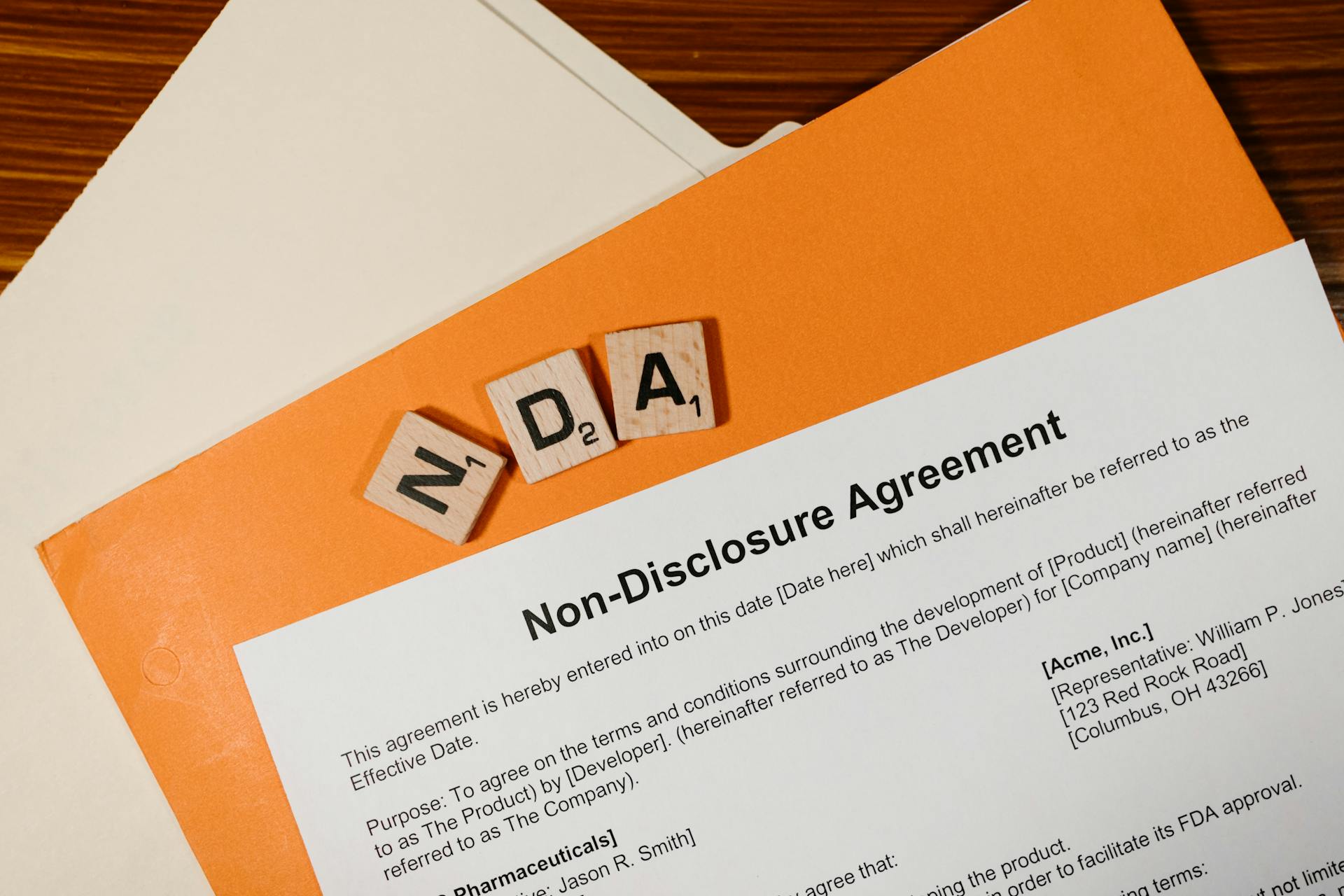
HIPAA compliance is a must for any organization handling ePHI, or electronic Protected Health Information. ePHI includes any PHI that's stored, transmitted, or received electronically.
To ensure HIPAA compliance, covered entities must implement administrative, technical, and physical safeguards to protect ePHI. This includes conducting risk analyses and implementing security measures to prevent unauthorized access.
A breach of ePHI can have serious consequences, including fines and penalties. In 2020, a healthcare organization was fined $1.6 million for a breach that exposed the ePHI of over 6,000 patients.
Covered entities must also provide training to employees on HIPAA policies and procedures. This includes training on how to handle ePHI, how to report a breach, and how to maintain confidentiality.
On a similar theme: Hipaa Training
What is PHI?
Protected health information, or PHI, is any information in the medical record or designated record set that can be used to identify an individual and was created, used, or disclosed in the course of providing a health care service.
Suggestion: Hipaa Data Retention Requirements
HIPAA regulations allow researchers to access and use PHI when necessary to conduct research that uses, creates, or discloses information that enters the medical record or is used for healthcare services, such as treatment, payment, or operations.
PHI is used in studies involving review of existing medical records for research information, like retrospective chart review.
Sponsored clinical trials that submit data to the U.S. Food and Drug Administration involve PHI and are therefore subject to HIPAA regulations.
In studies that produce new medical information, PHI is created in the course of the research, such as diagnosing a health condition or evaluating a new drug or health device, and that information will be entered into the medical record.
See what others are reading: No Surprises Act Regulations
Protected Health Information (PHI)
Protected Health Information (PHI) is any health information that includes any of the 18 elements identified by HIPAA and maintained by a covered entity or any information that can be reasonably used to identify a person.
PHI is information created or received by a healthcare provider relating to the past, present, or future physical or mental health or condition of a patient, the provision of healthcare to an individual, or the past, present, or future payment for the provision of healthcare to an individual until fifty years following the date of death of the individual.
The 18 identifiers that create PHI when linked to health information include names, geographical subdivisions, dates, phone numbers, fax numbers, electronic mail addresses, social security numbers, medical record numbers, and more.
Here are the 18 identifiers that create PHI:
- Names
- All geographical subdivisions smaller than a State, including street address, city, county, precinct, zip code, and their equivalent geocodes
- All elements of dates (except year) for dates directly related to an individual
- Phone numbers
- Fax numbers
- Electronic mail addresses
- Social Security numbers
- Medical record numbers
- Health plan beneficiary numbers
- Account numbers
- Certificate/license numbers
- Vehicle identifiers and serial numbers
- Device identifiers and serial numbers
- Web Universal Resource Locators (URLs)
- Internet Protocol (IP) address numbers
- Biometric identifiers
- Full face photographic images
- Any other unique identifying number, characteristic, or code
Some examples of Protected Health Information include medical records, billing information, and test results.
The Security Rule
The Security Rule is a crucial aspect of HIPAA compliance, and it's designed to be flexible and scalable to meet the unique needs of each covered entity. It requires covered entities to ensure the confidentiality, integrity, and availability of all electronic Protected Health Information (ePHI).
Suggestion: Covered Entity under Hipaa
The Security Rule has four main requirements: ensuring confidentiality, protecting against threats and hazards, protecting against unauthorized uses or disclosures, and ensuring compliance with these requirements by the workforce. Covered entities must also adopt, maintain, review, and update policies and procedures that are written, reasonable, and appropriate.
To determine the right security measures, covered entities must consider their size, complexity, and capabilities, as well as their technical infrastructure, hardware, and software security capabilities. They must also consider the costs of security measures and the probability and criticality of potential risks to ePHI.
Here are the key factors to consider when implementing security measures:
- Size and complexity of the organization
- Technical infrastructure, hardware, and software security capabilities
- Costs of security measures
- Probability and criticality of potential risks to ePHI
The Security Rule also requires covered entities to maintain written records of required actions, activities, or assessments for six years after their creation date or last effective date, whichever is later. This ensures that covered entities can demonstrate compliance with the Security Rule and provide evidence of their security measures in the event of an audit or breach.
Explore further: Hipaa Security Services
Administrative Safeguards
Administrative Safeguards are policies and procedures that protect ePHI and ensure compliance with the Security Rule. They cover training and procedures for employees, regardless of whether they have access to protected health information or not.
A Covered Entity or Business Associate is required to implement or address various Administrative Safeguards, including Security Management, which involves policies and procedures to prevent, detect, contain, and correct security violations. This includes identifying the security official responsible for developing and implementing these policies and procedures.
Workforce Security is also a key aspect, ensuring that all workforce members have appropriate access to ePHI and preventing unauthorized workforce members from obtaining access to ePHI. Role-based access management is crucial, authorizing access to ePHI only when such access is appropriate based on the user or recipient's role.
Security Awareness and Training is another essential requirement, implementing training for all workforce members on periodic security updates, procedures for malware detection and reporting, and procedures for monitoring logins. This training should also cover creating, changing, and safeguarding passwords.
Related reading: The Administrative Simplification Section of Hipaa
Security Incident Procedures are also required, identifying and responding to suspected or known security incidents, mitigating harmful effects, and documenting security incidents and their outcomes. Regular risk analysis and management are fundamentally important to ensure an entity's risk of a breach stays at an acceptable level.
Here is a summary of the key Administrative Safeguards:
- Security Management: policies and procedures to prevent, detect, contain, and correct security violations.
- Security Responsibility: identify the security official responsible for developing and implementing policies and procedures.
- Workforce Security: ensure all workforce members have appropriate access to ePHI and prevent unauthorized workforce members from obtaining access.
- Information (ePHI) Access Management: authorize access to ePHI based on the user or recipient's role.
- Security Awareness and Training: implement training for all workforce members on security updates and procedures.
- Security Incident Procedures: identify and respond to suspected or known security incidents.
- Contingency Plans: response to emergencies or other occurrences that damage systems that contain ePHI.
- Evaluation: periodic technical and nontechnical evaluations based on standards implemented under the Security Rule.
Integrity
Integrity is a crucial aspect of handling ePHI, and it's essential to understand what that means. The integrity of ePHI must never be destroyed or changed in any way that was not authorized.
In other words, once ePHI is created, it should remain unchanged throughout its handling. This includes any modifications, deletions, or additions that may occur. The ePHI must be preserved in its original form, without any unauthorized alterations.
This means that ePHI should not be tampered with or altered in any way that could compromise its accuracy or authenticity.
Readers also liked: Which of the following Is Not the Purpose of Hipaa
Availability and Safeguards
Availability is a crucial aspect of the HIPAA Security Rule, ensuring that ePHI is accessible when needed by those who need to access it. This is equally important as safeguarding the information.
The Security Rule requires Covered Entities and Business Associates to implement Administrative Safeguards, which include policies and procedures to ensure ePHI is available and accessible. This includes periodic technical and nontechnical evaluations based on standards implemented under the Security Rule.
Availability is a key component of the Security Rule, making sure that ePHI is safe and guarded as it should be. It's equally important to ensure that this information is available and accessible when needed by those who need to access it.
To ensure ePHI is available, Covered Entities and Business Associates must implement Administrative Safeguards, including Security Incident Procedures and Contingency Plans. These procedures identify and respond to suspected or known security incidents, mitigate harmful effects, and document security incidents and their outcomes.
Here are some key requirements for Availability:
- Implement Administrative Safeguards, including Security Incident Procedures and Contingency Plans.
- Ensure ePHI is safe and guarded as it should be.
- Make ePHI available and accessible when needed by those who need to access it.
Compliance and Enforcement
Compliance and Enforcement is a serious business, and violating HIPAA and the HIPAA Security Rule can result in both civil and criminal penalties.
NIU follows guidelines and checklists established by the National Institute of Standards and Technology (NIST), specifically NIST’s Special Publication (SP) 800-66, Revision 1: An Introductory Resource Guide for Implementing the HIPAA Security Rule, to assist in auditing compliance with HIPAA requirements.
Explore further: Security Standards Hipaa
Compliance
Compliance is a crucial aspect of HIPAA regulations. Violation of HIPAA and the HIPAA Security Rule includes both civil and criminal penalties.
To ensure compliance, institutions follow guidelines and checklists established by the National Institute of Standards and Technology (NIST), specifically NIST's Special Publication (SP) 800-66, Revision 1: An Introductory Resource Guide for Implementing the HIPAA Security Rule. This resource helps institutions audit their compliance with HIPAA requirements.
Expert compliance support can be a game-changer for organizations. Accountable allowed one organization to quickly establish Core Compliance with HIPAA as well as a firm foundation for their Security Program.
Worth a look: Enforcement Rule Hipaa
Revocation
Revocation is a crucial aspect of research compliance. Research participants can revoke their authorization in writing to the Principal Investigator at any time.
To do so, the participant must submit a written request, which must be witnessed and signed by a person who can attest to the participant's identity. This is especially important when the research involves sensitive information, such as mental health or developmental disability data.
If the research involves the collection of all information in the medical record, the revocation must also be witnessed and signed by a person who can attest to the participant's identity.
The IRB has a template, HIPAA Revocation Template Letter, available for investigators and participants to complete. This template can help ensure that the revocation process is properly documented.
Additional guidance on uses and disclosures not requiring authorization or an IRB waiver authorization can be found in the NMHC Policy on Research Privacy and Confidentiality and the Research Recruitment Guidelines FAQs. These resources cover situations such as:
- Research on decedents
- Preparatory to research
- De-identified data
- Limited data sets
When to Grant a Waiver or Alteration
A waiver or alteration of HIPAA authorization may be granted when the research poses no more than a minimal risk to the privacy of individuals. This is according to the required HIPAA waiver/alteration criteria referenced in HRP-441 – CHECKLIST HIPAA – Waiver Authorization.
The IRB may waive HIPAA authorization completely or issue a partial waiver, especially when the research also qualifies for a waiver of consent. A complete waiver of HIPAA may be granted when it's not possible to obtain the participant's signature, and it's not possible to provide the participant with the authorization information, such as for a retrospective review of medical records.
For more insights, see: Kaiser Hipaa Authorization
A partial waiver of HIPAA authorization may be granted when a study does not intend to obtain HIPAA authorization on behalf of the covered entity, but needs access to PHI for recruitment purposes. This is often the case when a study needs contact information from the Electronic Data Warehouse (EDW).
An alteration of HIPAA authorization may include an omission of one or more required elements of HIPAA-compliant authorization. For example, an alteration may be granted when the targeted participant population may not have access or skills to use technology that allows for an electronic signature, such as the elderly or people with limited resources.
To apply for both the waiver of consent and waiver of authorization, the PI must demonstrate how the study meets all of the required waiver/alteration criteria, and include the justification within the protocol.
You might like: Hipaa Access Control
Frequently Asked Questions
What is meant by confidentiality of ePHI?
Confidentiality of ePHI refers to the protection of sensitive health information from unauthorized access or disclosure. This ensures that only authorized individuals or organizations can view or share ePHI data
Does the HIPAA security rule only apply to ePHI?
The HIPAA Security Rule only applies to electronic Protected Health Information (ePHI). However, the HIPAA Privacy Rule covers all forms of protected health information, including electronic, written, and oral.
Sources
- https://www.niu.edu/doit/about/policies/hipaa-security-rule.shtml
- https://www.accountablehq.com/post/ephi
- https://www.hipaaexams.com/blog/electronic-phi-concerns
- https://cphs.berkeley.edu/hipaa/hipaa18.html
- https://irb.northwestern.edu/resources-guidance/consent-templates-hipaa-requirements/consent-hipaa/hipaa-phi-pii.html
Featured Images: pexels.com


